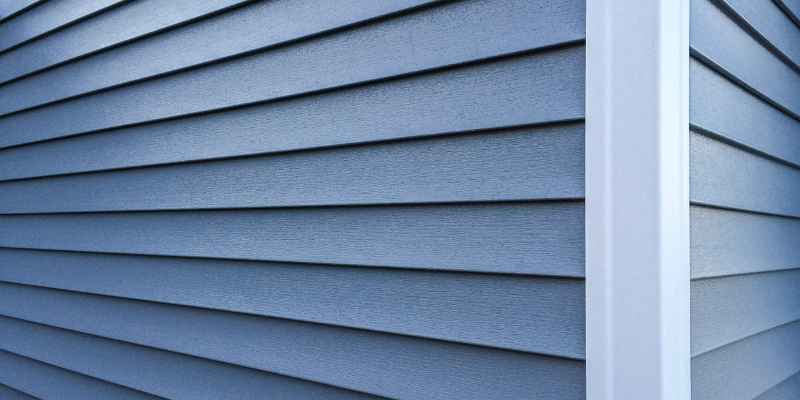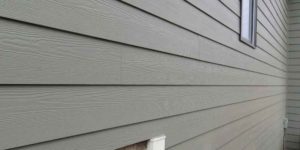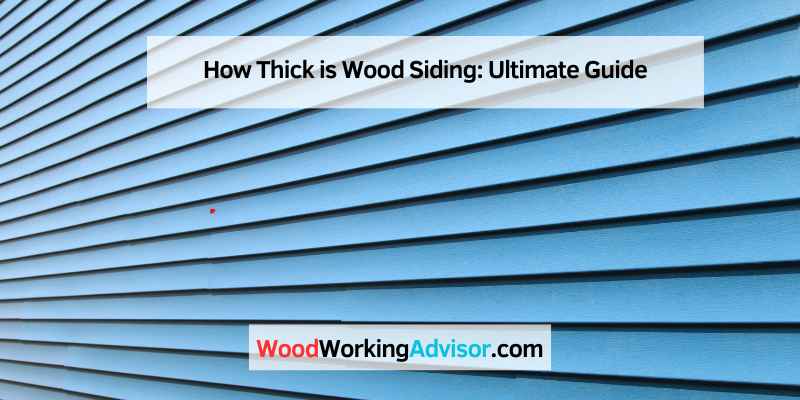Wood siding can vary in thickness depending on the type and style, but it typically ranges from 3/8 inch to 1 inch. Wood siding is a popular choice for homes due to its natural beauty and durability.
It can add warmth and charm to any exterior and comes in a variety of styles, such as clapboard, shiplap, and board and batten. Whether you’re looking for a rustic, traditional, or modern look, wood siding can be customized to suit your style.
In addition to its aesthetic appeal, wood siding also provides insulation and protection against the elements. It is important to choose the appropriate thickness of wood siding for your specific climate and location to ensure optimal performance and longevity.
Standard Sizes Of Wood Siding
Wood siding comes in various standard thicknesses, typically ranging between 3/8 to 1 inch. The thickness usually depends on the type of wood siding and the specific style chosen for installation. Each wood siding type has its own recommended thickness to ensure durability and aesthetic appeal.
Measurement In Inches
Wood siding is commonly available in various standard sizes, with the thickness being a critical aspect. The standard thickness of wood siding panels typically ranges from 3/8-inch to 1 inch. These widths provide options for homeowners and builders based on the desired aesthetic and structural requirements. However, it’s important to note that the actual thickness can vary based on the specific wood species and manufacturing process.
Comparison With Other Siding Materials
When comparing wood siding with other siding materials, it’s evident that wood offers unique characteristics. While vinyl siding thickness usually ranges from 0.035 to 0.055 inches, wood siding’s versatility and durability make it a favorable choice despite its slightly higher thickness. Additionally, wood siding’s thickness often outweighs that of fiber cement siding, which typically falls within the range of 5/16 to 1/2 inch. The substantial thickness of wood siding contributes to its resilience, making it an attractive option for various architectural styles.
Factors Affecting Wood Siding Thickness
When it comes to wood siding, thickness plays a crucial role in determining its durability and overall performance. The thickness of wood siding can be influenced by several factors, including the type of wood used and the climate considerations. Let’s explore these factors in more detail.
Type Of Wood
The type of wood used for siding can impact its thickness. Different wood species have varying densities and durability, which can affect the required thickness for optimal performance. For example, cedar wood siding is known for its natural resistance to decay and insect damage, often allowing for a thinner siding profile. On the other hand, softwood species like pine may require a thicker siding profile to ensure long-lasting protection against the elements.
Climate Considerations
The climate in which your home is located also plays a significant role in determining the ideal thickness of wood siding. In areas with extreme weather conditions, such as high humidity, intense sunlight, or harsh winters, thicker siding may be necessary to provide adequate insulation and protection against moisture and temperature fluctuations.
Additionally, the local building codes and regulations may specify minimum thickness requirements for wood siding based on the climate zone. Consulting with a local building professional or contractor can help ensure compliance with these regulations and select the appropriate thickness for your specific location.
In conclusion, the type of wood used and the climate considerations are two key factors that affect the thickness of wood siding. By considering these factors and selecting the right thickness for your specific needs, you can ensure the longevity and performance of your wood siding.
Determining The Right Thickness For Your Home
Choosing the appropriate thickness for wood siding is crucial for its longevity.
Thickness of wood siding affects the visual appeal of your home.
When selecting wood siding, knowing the right thickness can make a significant impact on both the durability and aesthetic of your property.
Common Types Of Wood Siding
Cedar plank siding is a popular choice due to its natural beauty and durability.
Clapboard siding, also known as bevel or lap siding, offers a classic look and weather resistance
Installation And Maintenance
When it comes to installing and maintaining wood siding, it is crucial to consider various factors such as the thickness of the siding panels. Understanding the installation process and proper maintenance techniques can help ensure the longevity and beauty of your wood siding.
Installing Wood Siding Panels
Proper installation of wood siding panels is essential to achieve a seamless and visually appealing look. When selecting wood siding panels, it’s important to note the thickness, as it can affect the overall strength and durability of the siding. The standard thickness of wood siding panels usually ranges from 3/8 inch to 1 inch.
During the installation process, it’s important to follow the manufacturer’s guidelines and use proper tools and techniques. Here are the key steps to install wood siding panels:
- Prepare the surface by ensuring it is clean, smooth, and free from any debris.
- Apply a weather-resistant barrier, such as house wrap, to protect the underlying structure from moisture.
- Start at the bottom of the wall and work your way up, ensuring each panel is properly aligned and leveled.
- Secure the panels using nails or screws, following the recommended spacing provided by the manufacturer.
- Leave proper gaps for expansion and contraction of the wood siding panels.
- Apply a suitable finish or sealant to protect the wood and enhance its longevity.
Maintaining And Repairing Wood Siding
Maintaining and repairing wood siding is essential to prevent damage and preserve its appearance over time. Regular maintenance can help extend the lifespan of your wood siding and minimize the need for costly repairs. Here are some maintenance and repair tips:
- Inspect your wood siding periodically for signs of damage, such as cracks, rot, or insect infestations.
- Clean your wood siding annually using a mild detergent and soft brush to remove dirt, mold, and mildew.
- Trim overgrown vegetation near the siding to prevent moisture accumulation and potential damage.
- Repair any damaged or rotten sections promptly to prevent further deterioration.
- Reapply a protective finish or sealant every few years to enhance the wood’s resistance to moisture and UV rays.
- Consider applying a wood preservative or stain to enhance the natural beauty of the wood and protect it from the elements.
By following these installation and maintenance practices, you can ensure that your wood siding remains in excellent condition and enhances the aesthetic appeal of your home for years to come.

Exploring Old Wood Siding Types
Old wood siding types not only add character and charm to a home, but they also have a rich historical significance that tells a story of the past. From traditional clapboard siding to rustic barn wood siding, each type has its own unique features and benefits.
Historical Significance Of Old Wood Siding
Old wood siding has been used for centuries and can be seen in many historical buildings and homes. The use of wood siding dates back to colonial times when it was the most common material available for construction. By exploring old wood siding types, we can better understand the architectural history of different regions and the craftsmanship that went into creating these beautiful exteriors.
Preservation And Restoration
Preserving and restoring old wood siding is not only about maintaining the aesthetic appeal of a building but also about honoring its historical significance. When it comes to preserving old wood siding, it’s important to understand the type of wood used, its thickness, and any treatments or finishes that were applied. This information helps in determining the best preservation and restoration methods to ensure that the wood siding remains in good condition for many years to come.
For instance, if you are dealing with clapboard siding, which is one of the most common old wood siding types, it is essential to know its thickness. Clapboard siding typically ranges from 3/8 inch to 1 inch in thickness, with narrower profiles being more prevalent in earlier constructions. Knowing the specific thickness of your clapboard siding will help you make informed decisions when it comes to repairs or replacements.
When restoring old wood siding, it’s vital to choose compatible materials and techniques that align with the original construction methods. Careful removal of damaged siding, proper repairs, and the use of suitable finishes will ensure that the historical integrity and aesthetic beauty of the wood siding are preserved.
In conclusion, exploring old wood siding types allows us to appreciate the historical significance of these materials and the craftsmanship they represent. Whether you are preserving or restoring old wood siding, understanding the thickness of the wood and adopting suitable preservation and restoration methods is crucial. By doing so, you can maintain the authenticity and beauty of these historical treasures for generations to come.

Frequently Asked Questions Of How Thick Is Wood Siding
What Is The Standard Size Of Wood Siding?
The standard size of wood siding typically ranges from 3/8 to 3/4 inches in thickness.
How Thick Is Siding In Inches?
Wood siding thickness can vary, but it is typically measured in inches. The exact thickness can depend on the type of wood siding being used.
How Thick Is Barn Wood Siding?
Barn wood siding typically ranges from 3/8 inch to 3/4 inch in thickness.
How Thick Is Cedar Plank Siding?
Cedar plank siding is usually 3/4 inch thick. It provides durability and a natural look.
Conclusion
Wood siding thickness can vary depending on the type and style of siding you choose. Some common thicknesses for wood siding can range from 1/2 inch to 3/4 inch. It’s important to consider the climate and conditions in your area when selecting the thickness of wood siding for your home.
Thicker siding can provide more durability and protection against the elements. Ultimately, consulting with a professional and considering your specific needs will help you determine the best thickness for your wood siding.


